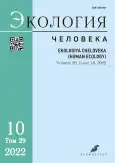Содержание химических элементов в биосредах организма юношей — жителей Крайнего Севера — на фоне повышенных физических нагрузок
- Авторы: Степанова Е.М.1, Луговая Е.А.1
-
Учреждения:
- Научно-исследовательский центр «Арктика» Дальневосточного отделения Российской академии наук
- Выпуск: Том 29, № 10 (2022)
- Страницы: 709-719
- Раздел: ОРИГИНАЛЬНЫЕ ИССЛЕДОВАНИЯ
- URL: https://journals.rcsi.science/1728-0869/article/view/108758
- DOI: https://doi.org/10.17816/humeco108758
- ID: 108758
Цитировать
Полный текст
Аннотация
Обоснование. Известно, что во время занятий спортом в организме человека происходят адаптивные процессы, которые помогают приспособиться к условиям регулярной физической нагрузки, и дизадаптивные процессы, связанные с высокой потерей биоэлементов и потребностью в них.
Цель исследования. Комплексный анализ элементного профиля организма спортсменов г. Магадана, имеющих высокие спортивные разряды, с выявлением характерных особенностей содержания химических элементов в разных биологических средах (волосы, цельная кровь).
Материалы и методы. Проведён комплексный анализ элементного профиля организма спортсменов г. Магадана в возрасте 19–25 лет (n=29). Контрольная группа включала юношей аналогичного возраста с обычным режимом физической активности (n=22). Определяли наиболее информативную биологическую среду для выявления хронического дисбаланса и оценки степени наиболее типичных нарушений с целью профилактики региональных дисэлементозов и повышения функциональных резервов организма. Вычисляли концентрацию 18 макро- и микроэлементов методами атомно-эмиссионной спектрометрии с индуктивно связанной аргоновой плазмой и масс-спектрометрии с индуктивно связанной аргоновой плазмой.
Результаты. Концентрация Ca, Co, Fe, Se, Zn в волосах спортсменов была выше аналогичного значения в группе юношей с обычным режимом физической активности. Медиана концентрации Na и P в крови также была выше у спортсменов, а K, Mg, Co, Fe, Se — в крови юношей из контрольной группы. В крови лиц контрольной группы выявлена бόльшая частота встречаемости дефицита Co, Cu, Zn, Fe, избыток Mg и Se, в группе «спорт» чаще встречается избыток Mn.
Заключение. Из представленных в работе данных нельзя сделать однозначный вывод о спорт-индуцированном изменении микроэлементного профиля организма. В некоторых случаях элементный портрет спортсменов схож с элементным портретом жителей Магадана с характерными чертами «северного типа», с выраженным именно в волосах дефицитом эссенциальных минералов, при этом частота встречаемого в волосах дефицита зачастую выше у юношей, не испытывающих повышенных нагрузок. Нами не обнаружено превышение содержания токсичных элементов или тяжёлых металлов в изученных биосредах. Считаем, что для долговременной оценки элементного дисбаланса у спортсменов, который формируется именно в условиях повышенной физической нагрузки, целесообразнее использовать спектральный анализ волос как аккумулирующего биологического субстрата, концентрация химических элементов в котором не подвергается суточным колебаниям на фоне изменения функциональных и психоэмоциональных состояний, а также пищевых предпочтений в течение дня.
Ключевые слова
Полный текст
Открыть статью на сайте журналаОб авторах
Евгения Михайловна Степанова
Научно-исследовательский центр «Арктика» Дальневосточного отделения Российской академии наук
Автор, ответственный за переписку.
Email: at-evgenia@mail.ru
ORCID iD: 0000-0002-2223-1358
SPIN-код: 4972-0152
научный сотрудник
Россия, МагаданЕлена Александровна Луговая
Научно-исследовательский центр «Арктика» Дальневосточного отделения Российской академии наук
Email: elena_plant@mail.ru
ORCID iD: 0000-0002-6583-4175
SPIN-код: 5825-7122
Scopus Author ID: https://www.scopus.com/authid/detail.uri?authorId=56728609500
ResearcherId: https://publons.com/researcher/3727949/elena-lugovaya/
к.б.н., доцент
Россия, МагаданСписок литературы
- Алиджанова И.Э., Нотова С.В., Кияева Е.В., Мирошников С.В. К вопросу об особенностях изменения макро и микроэлементного обмена на фоне интенсивной физической нагрузки // Вестник Оренбургского государственного университета. 2011. № 15. С. 19–21.
- Зырянова Е.А., Смоленский А.В., Григорянц И.А. Особенности построения рационального питания женщин спортсменок (энергетическое голодание как причина нарушений женской репродуктивной системы при физических нагрузках) // Теория и практика физической культуры. 2007. № 8. С. 66–68.
- Schoeller D.A. Integrating therapeutic and complementary nutrition // Medicine & Science in Sports & Exercise. 2007. Vol. 39. N 7. P. 1207.
- Гудков А.Б., Дёмин А.В., Долгобородова А.А., Быков А.В. Характеристика постурального контроля у флорболисток национальной сборной России в соревновательном периоде // Теория и практика физической культуры. 2017. № 2. С. 23–26.
- Нотова С.В., Кияева Е.В., Ермакова Н.В., и др. Элементный и биохимический профиль спортсменов с ограниченными физическими возможностями // Экология человека. 2018. Т. 25, № 6. С. 52–58. doi: 10.33396/1728-0869-2018-6-52-58
- McClung J.P., Gaffney-Stomberg E., Lee J.J. Female athletes: a population at risk of vitamin and mineral deficiencies affecting health and performance // J Trace Elem Med Biol. 2014. Vol. 28, N 4. P. 388–392. doi: 10.1016/j.jtemb.2014.06.022
- Скальный А.В., Зайцева И.П., Тиньков А.А. Микроэлементы и спорт. Персонализированная коррекция элементного статуса спортсменов / под общ. ред. А.В. Скального. Москва : Спорт, 2018. 288 с.
- Скальный А.В. Референтные значения концентраций химических элементов в волосах, полученные методом ИСП-АЭС (АНО Центр биотической медицины) // Микроэлементы в медицине. 2003. Т. 4, № 1. С. 55–56.
- Skalny A.V., Skalnaya M.G., Tinkov A.A., et al. Reference values of hair toxic trace elements content in occupationally non-exposed Russian population // Environ Toxicol Pharmacol. 2015. Vol. 40, N 1. P. 18–21. doi: 10.1016/j.etap.2015.05.004
- Луговая Е.А., Степанова Е.М. Региональные показатели содержания макро- и микроэлементов в организме жителей г. Магадана. Магадан : Типография «Экспресс-полиграфия», 2019. 27 с.
- Похачевский А.Л., Петров А.Б., Анкудинов Н.В. Восстановление физической работоспособности квалифицированных борцов-самбистов в годичном цикле подготовки // Ученые записки университета им. П.Ф. Лесгафта. 2011. № 11. С. 126–130.
- Kunstel K. Calcium requirements for the athlete // Curr Sports Med Rep. 2005. Vol. 4, N 4. P. 203–206. doi: 10.1097/01.csmr.0000306208.56939.01
- Троегубова Н.А., Рылова Н.В., Самойлов А.С. Микронутриенты в питании спортсменов // Практическая медицина. 2014. № 1. С. 46–49.
- Луговая Е.А., Максимов А.Л. Элементный профиль организма жителей Северо-Востока России // Вопросы биологической, медицинской и фармацевтической химии. 2012. № 6. С. 17–21.
- Луговая Е.А., Степанова Е.М. Структура элементного дисбаланса в организме жителей г. Магадана // Здоровье населения и среда обитания — ЗНиСо. 2015. № 2. С. 4–6.
- Степанова Е.М., Луговая Е.А. Возрастные и гендерные изменения содержания химических элементов в волосах жителей г. Магадана трудоспособного возраста В сб.: Ответственный редактор Н.А. Горячев. Наука Северо-Востока России: фундаментальные и прикладные исследования в Северной Пацифике и Арктике. Материалы докладов юбилейной конференции, посвященной 60-летию СВКНИИ им. Н.А. Шило ДВО РАН; 2020 Март 05–06; Магадан, 2020. С. 201–203.
- Некрасов В.И., Скальный А.В., Дубовой Р.М. Роль микроэлементов в повышении функциональных резервов организма человека // Вестник Российской военно-медицинской академии. 2006. № 1. С. 111–113.
- Гараева О.И. Влияние интенсивной физической нагрузки на микроэлементный статус организма // Buletinul Academiei de Ştiinţe a Moldovei. Ştiinţele Vieţii. 2012. № 3. С. 53–59.
Дополнительные файлы









